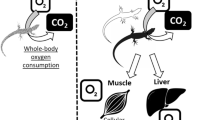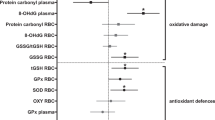Abstract
Stress hormones, such as corticosterone, play a crucial role in orchestrating physiological reaction patterns shaping adapted responses to stressful environments. Concepts aiming at predicting individual and population responses to environmental stress typically consider that stress hormones and their effects on metabolic rate provide appropriate proxies for the energy budget. However, uncoupling between the biochemical processes of respiration, ATP production, and free-radical production in mitochondria may play a fundamental role in the stress response and associated life histories. In this study, we aim at dissecting sub-cellular mechanisms that link these three processes by investigating both whole-organism metabolism, liver mitochondrial oxidative phosphorylation processes (O2 consumption and ATP production) and ROS emission in Zootoca vivipara individuals exposed 21 days to corticosterone relative to a placebo. Corticosterone enhancement had no effect on mitochondrial activity and efficiency. In parallel, the corticosterone treatment increased liver mass and mitochondrial protein content suggesting a higher liver ATP production. We also found a negative correlation between mitochondrial ROS emission and plasma corticosterone level. These results provide a proximal explanation for enhanced survival after chronic exposure to corticosterone in this species. Importantly, none of these modifications affected resting whole-body metabolic rate. Oxygen consumption, ATP, and ROS emission were thus independently affected in responses to corticosterone increase suggesting that concepts and models aiming at linking environmental stress and individual responses may misestimate energy allocation possibilities.



Similar content being viewed by others
References
Andres AM, Stotland A, Queliconi BB, Gottlieb RA (2015) A time to reap, a time to sow: mitophagy and biogenesis in cardiac pathophysiology. J Mol Cell Cardiol 78:62–72
Artacho P, Jouanneau I, Le Galliard JF (2013) Interindividual variation in thermal sensitivity of maximal sprint speed, thermal behavior, and resting metabolic rate in a lizard. Physiol Biochem Zool 86:458–469
Arvier M, Lagoutte L, Johnson G, Dumas JF, Sion B, Grizard G, Malthiery Y, Simard G, Ritz P (2007) Adenine nucleotide translocator promotes oxidative phosphorylation and mild uncoupling in mitochondria after dexamethasone treatment. Am J Physiol Endocrinol Metab 293:E1320–E1324
Beavis AD, Lehninger AL (1986) The upper and lower limits of the mechanistic stoichiometry of mitochondrial oxidative phosphorylation: stoichiometry of oxidative phosphorylation. Eur J Biochem 158:315–322
Brand MD (2000) Uncoupling to survive? The role of mitochondrial inefficiency in ageing. Exp Gerontol 35:811–820
Brand MD (2005) The efficiency and plasticity of mitochondrial energy transduction. Biochem Soc Trans 33:897–904
Brown JH, Gillooly JF, Allen AP, Savage VN, West GB (2004) Toward a metabolic theory of ecology. Ecology 85:1771–1789
Caro P, Gomez J, Sanz A, Portero-Otin M, Pamplona R, Barja G (2007) Effect of graded corticosterone treatment on aging-related markers of oxidative stress in rat liver mitochondria. Biogerontology 8:1–11
Chida Y, Sudo N, Kubo C (2006) Does stress exacerbate liver disease? J Gastroenter Hepatol 20:202–208
Cote J, Clobert J, Meylan S, Fitze PS (2006) Experimental enhancement of corticosterone levels positively affects subsequent male survival. Horm Behav 49:320–327
Cote J, Meylan S, Clobert J, Voituron Y (2010) Carotenoid-based coloration, oxidative stress and corticosterone in common lizards. J Exp Biol 213:2116–2124
Crossin GT, Love OP, Cooke SJ, Williams TD (2016) Glucocorticoid manipulations in free-living animals: considerations of dose delivery, life-history context and reproductive state. Funct Ecol 30:116–125
Dauphin-Villemant C, Xavier F (1987) Nychthemeral variations of plasma corticosteroids in captive female Lacerta vivipara Jacquin: influence of stress and reproductive state. Gen Comp Endocrinol 67:292–302
Desquiret V et al (2006) Dinitrophenol-induced mitochondrial uncoupling in vivo triggers respiratory adaptation in HepG2 cells. Biochem Biophys Acta 1757:21–30
Dhabhar FS, McEwen BS, Spencer RL (1997) Adaptation to prolonged or repeated stress—comparison between rat strains showing intrinsic differences in reactivity to acute stress. Neuroendocrinology 65:360–368
Dowling DK, Simmons LW (2009) Reactive oxygen species as universal constraints in life-history evolution. Proc Biol Sci 276:1737–1745
Du J et al (2009) Dynamic regulation of mitochondrial function by glucocorticoids. Proc Natl Acad Sci USA 106:3543–3548
Duclos M, Gouarne C, Martin C, Rocher C, Mormede P, Letellier T (2004) Effects of corticosterone on muscle mitochondria identifying different sensitivity to glucocorticoids in Lewis and Fischer rats. Am J Physiol 286:E159–E167
Dumas JF et al (2003) Mitochondrial energy metabolism in a model of undernutrition induced by dexamethasone. Br J Nutr 90:969–977
Durant SE, Romero LM, Talent LG, Hopkins WA (2008) Effect of exogenous corticosterone on respiration in a reptile. Gen Comp Endocrinol 156:126–133
Glazier DS (2015) Is metabolic rate a universal ‘pacemaker’ for biological processes? Biol Rev 90:377–407
Isaksson C, Sheldon BC, Uller T (2011) The challenges of integrating oxidative stress into life-history biology. Bioscience 61:194–202
Jani MS, Telang SD, Katyare SS (1991) Effect of corticosterone treatment on energy metabolism in rat liver mitochondria. J Steroid Biochem Mol Biol 38:587–591
Kimberg DV, Loud AV, Wiener J (1968) Cortisone-induced alterations in mitochondrial function and structure. J Cell Biol 37:63–79
Kooijman SALM (2010) Dynamic energy budget theory for metabolic organisation, 3rd edn. Cambridge University Press, Cambridge
Liang SW et al (2017) Seasonal variation of metabolism in lizard Phrynocephalus vlangalii at high altitude. Comp Biochem Physiol A 203:341–347
Lighton JRB (2008) Measuring metabolic rates: a manual for scientists. Oxford University Press, Oxford
Mason RT (1992) Reptilian pheromones. In: Gans C, Crews D (eds) Biology of the Reptilia, vol 18. University of Chicago Press, Chicago, pp 114–228
McEwen BS (2007) Physiology and neurobiology of stress and adaptation: central role of the brain. Physiol Rev 87:873–904
McEwen BS, Wingfield JC (2003) The concept of allostasis in biology and biomedicine. Horm Behav 43:2–15
Metcalfe NB, Alonso-Alvarez C (2010) Oxidative stress as a life-history constraint: the role of reactive oxygen species in shaping phenotypes from conception to death. Funct Ecol 24:984–996
Meylan S, Clobert J (2005) Is corticosterone-mediated phenotype development adaptive? Maternal corticosterone treatment enhances survival in male lizards. Horm Behav 48:44–52
Meylan S, Dufty AM, Clobert J (2003) The effect of transdermal corticosterone application on plasma corticosterone levels in pregnant Lacerta vivipara. Comp Biochem Physiol A Mol Integr Physiol 134:497–503
Meylan S, Haussy C, Voituron Y (2010) Physiological actions of corticosterone and its modulation by an immune challenge in reptiles. Gen Comp Endocrinol 169:158–166
Miles DB, Calsbeek R, Sinervo B (2007) Corticosterone, locomotor performance, and metabolism in side-blotched lizards (Uta stansburiana). Horm Behav 51:548–554
Monaghan P, Metcalfe NB, Torres R (2009) Oxidative stress as a mediator of life history trade-offs: mechanisms, measurements and interpretation. Ecol Lett 12:75–92
Monternier PA, Marmillot V, Rouanet JL, Roussel D (2014) Mitochondrial phenotypic flexibility enhances energy savings during winter fast in king penguin chicks. J Exp Biol 217:2691–2697
Morici LA, Elsey RM, Lance VA (1997) Effects of long-term corticosterone implants on growth and immune function in juvenile alligators, Alligator mississippiensis. J Exp Zool 279:156–162
Nisbet RM, Jusup M, Klanjscek T, Pecquerie L (2012) Integrating dynamic energy budget (DEB) theory with traditional bioenergetic models. J Exp Biol 215:892–902
Palacios MG, Sparkman AM, Bronikowski AM (2012) Corticosterone and pace of life in two life-history ecotypes of the garter snake Thamnophis elegans. Gen Comp Endocrinol 175:443–448
Pandya JD, Agarwal NA, Katyare SS (2004) Effect of dexamethasone treatment on oxidative energy metabolism in rat liver mitochondria during postnatal developmental periods. Drug Chem Toxicol 27:389–403
Picard M, Juster RP, McEwen BS (2014) Mitochondrial allostatic load puts the ‘gluc’ back in glucocorticoids. Nat Rev Endocrinol 10:303–310
Price CA et al (2012) Testing the metabolic theory of ecology. Ecol Lett 15:1465–1474
Psarra AM, Sekeris CE (2011) Glucocorticoids induce mitochondrial gene transcription in HepG2 cells: role of the mitochondrial glucocorticoid receptor. Biochem Biophys Acta 1813:1814–1821
Ricklefs RE, Wikelski M (2002) The physiology-life history nexus. Trends Ecol Evol 17:462–468
Robert KA, Bronikowski AM (2010) Evolution of senescence in nature: physiological evolution in populations of garter snake with divergent life histories. Am Nat 175:E147–E159
Roma LP, Souza KL, Carneiro EM, Boschero AC, Bosqueiro JR (2012) Pancreatic islets from dexamethasone-treated rats show alterations in global gene expression and mitochondrial pathways. Gen Physiol Biophys 31:65–76
Romero LM, Dickens MJ, Cyr NE (2009) The reactive scope model—a new model integrating homeostasis, allostasis, and stress. Horm Behav 55:375–389
Roussel D, Dumas JF, Simard G, Malthiery Y, Ritz P (2004) Kinetics and control of oxidative phosphorylation in rat liver mitochondria after dexamethasone treatment. Biochem J 382:491–499
Salin K, Luquet E, Rey B, Roussel D, Voituron Y (2012a) Alteration of mitochondrial efficiency affects oxidative balance, development and growth in frog (Rana temporaria) tadpoles. J Exp Biol 215:863–869
Salin K, Roussel D, Rey B, Voituron Y (2012b) David and goliath: a mitochondrial coupling problem? J Exp Zool A 317:283–293
Salin K, Auer SK, Rey B, Selman C, Metcalfe NB (2015) Variation in the link between oxygen consumption and ATP production, and its relevance for animal performance. Proc Biol Sci 282:20151028
Sapolsky RM, Romero LM, Munck AU (2000) How do glucocorticoids influence stress responses? Integrating permissive, suppressive, stimulatory, and preparative actions. Endocr Rev 21:55–89
Sinervo B (1999) Mechanistic analysis of natural selection and a refinement of lack’s and William’s principles. Am Nat 154:S26–S42
Sinervo B, DeNardo DF (1996) Costs of reproduction in the wild: path analysis of natural selection and experimental tests of causation. Evolution 50:1299–1313
Sommer AM, Portner HO (2004) Mitochondrial function in seasonal acclimatization versus latitudinal adaptation to cold in the lugworm Arenicola marina (L.). Physiol Biochem Zool 77:174–186
Strack AM, Bradbury MJ, Dallman MF (1995) Corticosterone decreases nonshivering thermogenesis and increases lipid storage in brown adipose tissue. Am J Physiol 268:R183–R191
Team RDC (2008) R: a language and environment for statistical computing. R Foundation for Statistical Computing, Vienna
Zera AJ, Potts J, Kobus K (1998) The physiology of life-history trade-offs: experimental analysis of a hormonally induced life-history trade-off in Gryllus assimilis. Am Nat 152:7–23
Acknowledgements
We are thankful to field assistants and technical staff at CEREEP-Ecotron IleDeFrance for their support, especially Hugo Mell. This study was funded by the Centre National de la Recherche Scientifique (CNRS), the Agence Nationale de la Recherche (ANR-13-JSV7-0011-01 to S.M.) and the Région Île-de-France R2DS program (Grant 2013-08 to S.M., J.F.L.G. and R.J.). The authors declare no competing or financial interests.
Author information
Authors and Affiliations
Contributions
YV, SM, and JFLG conceived, designed the study, and analyzed the data. RJ ensured animal husbandry, hormonal treatment and performed the statistical analyses. CH ensured plasma corticosterone measurements. DR and CR conceived and conducted the bioenergetics studies and performed the ROS production assessment. YV, SM, and JFLG wrote the manuscript; other authors provided editorial advice.
Corresponding author
Additional information
Communicated by Deron E. Burkepile.
Electronic supplementary material
Below is the link to the electronic supplementary material.
Rights and permissions
About this article
Cite this article
Voituron, Y., Josserand, R., Le Galliard, JF. et al. Chronic stress, energy transduction, and free-radical production in a reptile. Oecologia 185, 195–203 (2017). https://doi.org/10.1007/s00442-017-3933-1
Received:
Accepted:
Published:
Issue Date:
DOI: https://doi.org/10.1007/s00442-017-3933-1




